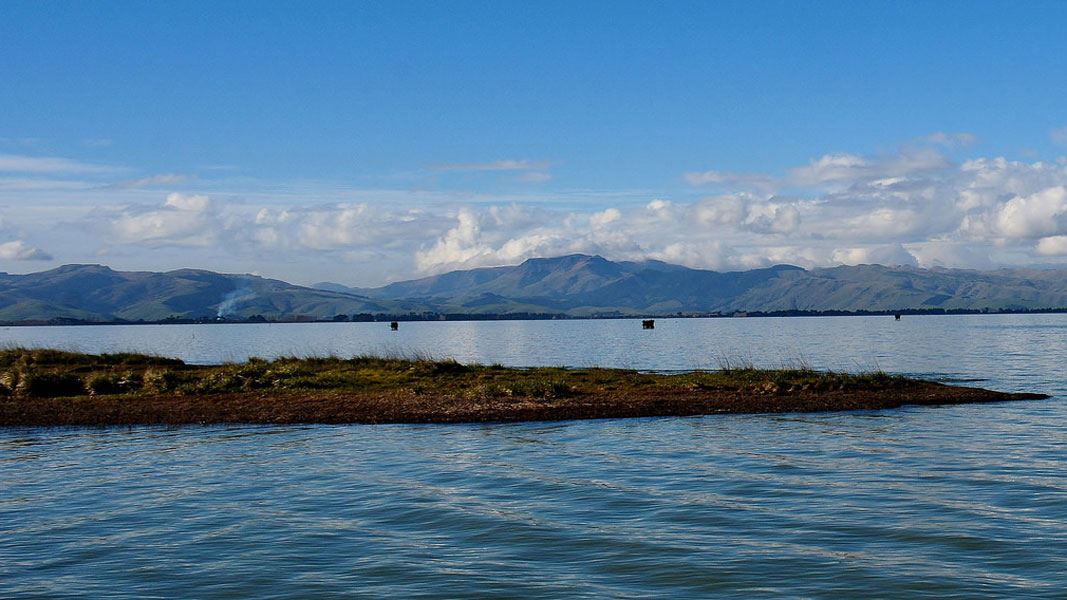Note that algal blooms on the lake can be extremely toxic to humans and animals.
The area is commonly used for gamebird hunting.
There are many access points to the lake shore.
Buses run to Lincoln and Halswell from the Square. There is a bus service to Akaroa, along State Highway 75, which runs along the eastern side of Te Waihora, past Birdlings Flat.
Te Waihora experiences toxic algal blooms which are hazardous to human and animal health (especially dogs).
Be cautious around the native stinging swamp nettle (urtica perconfusa).
We strongly urge you to check the current status of the lake on the Environment Canterbury Facebook page before visiting the area.
Weather changes can have serious effects on water levels. Care is needed if going into the water.
Fires are not permitted on any reserve around Te Waihora.
Wetlands
Te Waihora/Lake Ellesmere is the most important wetland habitat of its type in New Zealand, providing essential habitats for a large range of bird, plant and invertebrate species. A 1990 National Water Conservation Order declared it as an outstanding wildlife habitat.
To Ngāi Tahu it represents a major mahinga kai and an important source of mana, to all New Zealanders it is an important location for both commercial and recreational activities.
Te Waihora covers about 20,000 hectares, about the same as Lake Wānaka. It is an unusual lagoon, salty and shallow, with an average depth of 1.4 metres with a maximum depth of 2.7 metres near Kaituna.. It is a brackish coastal lagoon that is termed eutrophic ie, rich in plant nutrients.
DOC looks after approximately 35% of the margin of Te Waihora, plus other lands in the wider catchment area, the largest of which is McQueen’s Lagoon on the Halswell River/Huritini.
Wildlife
Te Waihora is of outstanding national and international importance for wildlife. 166 species of birds have been recorded here, including 133 indigenous species - with up to 98,000 birds on the lake at one time. At least 37 species breed in the lake and are resident during the year.
There are number of wildlife reserves around the lake: Harts Creek, Selwyn, some of which are also refuges, offering greater protection.
The lake supports a diverse range of introduced and native fish including whitebait/īnanga and tūna/eel. 43 species of fish have been recorded from Te Waihora and its tributaries, of which six are exotic species eg, trout, salmon. Basking sharks and stingrays have also been spotted in the lake at different times.
Kaitorete Spit
Kaitorete Spit (actually a barrier formation) is an impressive landform, about 28 km long. It was formed about 6000 years ago by gravels transported by the Rakaia River and pushed into place by the Pacific Ocean.
It’s the largest remaining area in New Zealand of native sand binder/pingao, a bright-orange plant prized for weaving. Kaitorete is also home to other threatened plants and animals, some of which are unique to this location, such as woolly head Crapspedia ‘Kaitorete’, and a flightless moth! It’s a fantastic place to spot katipo spiders and lizards too.
Te Waihora is an area of cultural, natural, historic, recreational and commercial importance to many people. To Ngāi Tahu, Te Waihora represents a major gathering place for food and natural materials and an important source of mana.
Arthur's Pass National Park Visitor Centre
| Phone: | +64 3 318 9211 |
| Email: | arthurspassvc@doc.govt.nz |
| Address: | 104 West Coast Road Arthur's Pass 7654 |
| Hours: | Visitor centre hours and services |
